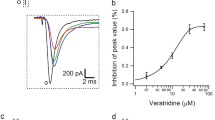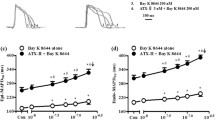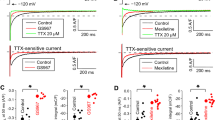Abstract
SKF-96365 (1-(beta-[3-(4-methoxy-phenyl) propoxy]-4-methoxyphenethyl)-1H-imidazole hydrochloride) is a general TRPC channel antagonist commonly used to characterize the potential functions of TRPC channels in cardiovascular system. Recent reports showed that SKF-96365 induced a reduction in cardiac conduction. The present study investigates whether the reduced cardiac conduction caused by SKF-96365 is related to the blockade of voltage-gated sodium current (I Na) in rat ventricular myocytes using the whole-cell patch voltage-clamp technique. It was found that SKF-96365 inhibited I Na in rat ventricular myocytes in a concentration-dependent manner. The compound (1 μM) negatively shifted the potential of I Na availability by 9.5 mV, increased the closed-state inactivation of I Na, and slowed the recovery of I Na from inactivation. The inhibition of cardiac I Na by SKF-96365 was use-dependent and frequency-dependent, and the IC50 was decreased from 1.36 μM at 0.5 Hz to 1.03, 0.81, 0.61, 0.56 μM at 1, 2, 5, 10 Hz, respectively. However, the selective TRPC3 antagonist Pyr3 decreased cardiac I Na by 8.5 % at 10 μM with a weak use and frequency dependence. These results demonstrate that the TRPC channel antagonist SKF-96365 strongly blocks cardiac I Na in use-dependent and frequency-dependent manners. Caution should be taken for interpreting the alteration of cardiac electrical activity when SKF-96365 is used in native cells as a TRPC antagonist.








Similar content being viewed by others
References
Baba A, Yasui T, Fujisawa S, Yamada RX, Yamada MK, Nishiyama N, Matsuki N, Ikegaya Y (2003) Activity-evoked capacitative Ca2+ entry: implications in synaptic plasticity. J Neurosci 23:7737–7741
Balser JR (2001) The cardiac sodium channel: gating function and molecular pharmacology. J Mol Cell Cardiol 33:599–613. doi:10.1006/jmcc.2000.1346
Beech DJ (2013) Characteristics of transient receptor potential canonical calcium-permeable channels and their relevance to vascular physiology and disease. Circ J 77:570–579
Brau ME, Dreimann M, Olschewski A, Vogel W, Hempelmann G (2001) Effect of drugs used for neuropathic pain management on tetrodotoxin-resistant Na(+) currents in rat sensory neurons. Anesthesiology 94:137–144
Brette F, Orchard CH (2006) Density and sub-cellular distribution of cardiac and neuronal sodium channel isoforms in rat ventricular myocytes. Biochem Biophys Res Commun 348:1163–1166. doi:10.1016/j.bbrc.2006.07.189
Carmeliet E, Mubagwa K (1998) Antiarrhythmic drugs and cardiac ion channels: mechanisms of action. Prog Biophys Mol Biol 70:1–72
Clancy CE, Kass RS (2002) Defective cardiac ion channels: from mutations to clinical syndromes. J Clin Invest 110:1075–1077. doi:10.1172/JCI16945
Clapham DE, Runnels LW, Strubing C (2001) The TRP ion channel family. Nat Rev Neurosci 2:387–396. doi:10.1038/35077544
Ding J, Xiao Y, Lu D, Du YR, Cui XY, Chen J (2011) Effects of SKF-96365, a TRPC inhibitor, on melittin-induced inward current and intracellular Ca2+ rise in primary sensory cells. Neurosci Bull 27:135–142. doi:10.1007/s12264-011-1018-4
Ding J, Zhang JR, Wang Y, Li CL, Lu D, Guan SM, Chen J (2012) Effects of a non-selective TRPC channel blocker, SKF-96365, on melittin-induced spontaneous persistent nociception and inflammatory pain hypersensitivity. Neurosci Bull 28:173–181. doi:10.1007/s12264-012-1213-y
Fozzard HA (2002) Cardiac sodium and calcium channels: a history of excitatory currents. Cardiovasc Res 55:1–8
Franzius D, Hoth M, Penner R (1994) Non-specific effects of calcium entry antagonists in mast cells. Pflugers Arch 428:433–438
Gao Z, Lau CP, Wong TM, Li GR (2004) Protein tyrosine kinase-dependent modulation of voltage-dependent potassium channels by genistein in rat cardiac ventricular myocytes. Cell Signal 16:333–341
Harada M, Luo X, Qi XY, Tadevosyan A, Maguy A, Ordog B, Ledoux J, Kato T, Naud P, Voigt N, Shi Y, Kamiya K, Murohara T, Kodama I, Tardif JC, Schotten U, Van Wagoner DR, Dobrev D, Nattel S (2012) Transient receptor potential canonical-3 channel-dependent fibroblast regulation in atrial fibrillation. Circulation 126:2051–2064. doi:10.1161/CIRCULATIONAHA.112.121830
Hong SJ, Lin WW, Chang CC (1994) Inhibition of the sodium channel by SK&F 96365, an inhibitor of the receptor-operated calcium channel, in mouse diaphragm. J Biomed Sci 1:172–178
Jan CR, Ho CM, Wu SN, Tseng CJ (1999) Multiple effects of 1-[beta-[3-(4-methoxyphenyl)propoxy]-4-methoxyphenethyl]-1H-imidazole hydrochloride (SKF 96365) on Ca2+ signaling in MDCK cells: depletion of thapsigargin-sensitive Ca2+ store followed by capacitative Ca2+ entry, activation of a direct Ca2+ entry, and inhibition of thapsigargin-induced capacitative Ca2+ entry. Naunyn Schmiedebergs Arch Pharmacol 359:92–101
Ju YK, Chu Y, Chaulet H, Lai D, Gervasio OL, Graham RM, Cannell MB, Allen DG (2007) Store-operated Ca2+ influx and expression of TRPC genes in mouse sinoatrial node. Circ Res 100:1605–1614. doi:10.1161/CIRCRESAHA.107.152181
Kaneko Y, Szallasi A (2013) TRP channels as therapeutic targets. Curr Top Med Chem 13:241–243
Kim SH, Choi YM, Jang JY, Chung S, Kang YK, Park MK (2007) Nonselective cation channels are essential for maintaining intracellular Ca2+ levels and spontaneous firing activity in the midbrain dopamine neurons. Pflugers Arch 455:309–321. doi:10.1007/s00424-007-0279-2
Kim SJ, Kim YS, Yuan JP, Petralia RS, Worley PF, Linden DJ (2003) Activation of the TRPC1 cation channel by metabotropic glutamate receptor mGluR1. Nature 426:285–291. doi:10.1038/nature02162
Kiselyov K, Xu X, Mozhayeva G, Kuo T, Pessah I, Mignery G, Zhu X, Birnbaumer L, Muallem S (1998) Functional interaction between InsP3 receptors and store-operated Htrp3 channels. Nature 396:478–482. doi:10.1038/24890
Kiyonaka S, Kato K, Nishida M, Mio K, Numaga T, Sawaguchi Y, Yoshida T, Wakamori M, Mori E, Numata T, Ishii M, Takemoto H, Ojida A, Watanabe K, Uemura A, Kurose H, Morii T, Kobayashi T, Sato Y, Sato C, Hamachi I, Mori Y (2009) Selective and direct inhibition of TRPC3 channels underlies biological activities of a pyrazole compound. Proc Natl Acad Sci U S A 106:5400–5405. doi:10.1073/pnas.0808793106
Koenig S, Schernthaner M, Maechler H, Kappe CO, Glasnov TN, Hoefler G, Braune M, Wittchow E, Groschner K (2013) A TRPC3 blocker, ethyl-1-(4-(2,3,3-trichloroacrylamide)phenyl)-5-(trifluoromethyl)-1H-pyrazole-4-c arboxylate (Pyr3), prevents stent-induced arterial remodeling. J Pharmacol Exp Ther 344:33–40. doi:10.1124/jpet.112.196832
Lei M, Zhang H, Grace AA, Huang CL (2007) SCN5A and sinoatrial node pacemaker function. Cardiovasc Res 74:356–365. doi:10.1016/j.cardiores.2007.01.009
Li GR, Baumgarten CM (2001) Modulation of cardiac Na+ current by gadolinium, a blocker of stretch-induced arrhythmias. Am J Physiol Heart Circ Physiol 280:H272–H279
Li GR, Sun HY, Zhang XH, Cheng LC, Chiu SW, Tse HF, Lau CP (2009) Omega-3 polyunsaturated fatty acids inhibit transient outward and ultra-rapid delayed rectifier K+ currents and Na+ current in human atrial myocytes. Cardiovasc Res 81:286–293. doi:10.1093/cvr/cvn322
Liu B, Freyer AM, Hall IP (2007) Bradykinin activates calcium-dependent potassium channels in cultured human airway smooth muscle cells. Am J Physiol Lung Cell Mol Physiol 292:L898–L907. doi:10.1152/ajplung.00461.2005
Liu D, Scholze A, Zhu Z, Kreutz R, Wehland-von-Trebra M, Zidek W, Tepel M (2005) Increased transient receptor potential channel TRPC3 expression in spontaneously hypertensive rats. Am J Hypertens 18:1503–1507. doi:10.1016/j.amjhyper.2005.05.033
Liu H, Sun HY, Lau CP, Li GR (2007) Regulation of voltage-gated cardiac sodium current by epidermal growth factor receptor kinase in guinea pig ventricular myocytes. J Mol Cell Cardiol 42:760–768. doi:10.1016/j.yjmcc.2006.10.013
Mangoni ME, Nargeot J (2008) Genesis and regulation of the heart automaticity. Physiol Rev 88:919–982. doi:10.1152/physrev.00018.2007
Merritt JE, Armstrong WP, Benham CD, Hallam TJ, Jacob R, Jaxa-Chamiec A, Leigh BK, McCarthy SA, Moores KE, Rink TJ (1990) SK&F 96365, a novel inhibitor of receptor-mediated calcium entry. Biochem J 271:515–522
Nilius B (2013) Transient receptor potential TRP channels as therapeutic drug targets: next round! Curr Top Med Chem 13:244–246
Nilius B, Owsianik G, Voets T, Peters JA (2007) Transient receptor potential cation channels in disease. Physiol Rev 87:165–217. doi:10.1152/physrev.00021.2006
Park DS, Fishman GI (2014) Nav-igating through a complex landscape: SCN10A and cardiac conduction. J Clin Invest 124:1460–1462. doi:10.1172/JCI75240
Pena F, Ordaz B (2008) Non-selective cation channel blockers: potential use in nervous system basic research and therapeutics. Mini Rev Med Chem 8:812–819
Pu J, Balser JR, Boyden PA (1998) Lidocaine action on Na+ currents in ventricular myocytes from the epicardial border zone of the infarcted heart. Circ Res 83:431–440
Quick K, Zhao J, Eijkelkamp N, Linley JE, Rugiero F, Cox JJ, Raouf R, Gringhuis M, Sexton JE, Abramowitz J, Taylor R, Forge A, Ashmore J, Kirkwood N, Kros CJ, Richardson GP, Freichel M, Flockerzi V, Birnbaumer L, Wood JN (2012) TRPC3 and TRPC6 are essential for normal mechanotransduction in subsets of sensory neurons and cochlear hair cells. Open Biol 2:120068. doi:10.1098/rsob.120068
Rose RA, Belke DD, Maleckar MM, Giles WR (2012) Ca(2+) entry through TRP-C channels regulates fibroblast biology in chronic atrial fibrillation. Circulation 126:2039–2041. doi:10.1161/CIRCULATIONAHA.112.138065
Sabourin J, Robin E, Raddatz E (2011) A key role of TRPC channels in the regulation of electromechanical activity of the developing heart. Cardiovasc Res 92:226–236. doi:10.1093/cvr/cvr167
Schwarz G, Droogmans G, Nilius B (1994) Multiple effects of SK&F 96365 on ionic currents and intracellular calcium in human endothelial cells. Cell Calcium 15:45–54
Singh A, Hildebrand ME, Garcia E, Snutch TP (2010) The transient receptor potential channel antagonist SKF96365 is a potent blocker of low-voltage-activated T-type calcium channels. Br J Pharmacol 160:1464–1475. doi:10.1111/j.1476-5381.2010.00786.x
Varnai P, Hunyady L, Balla T (2009) STIM and Orai: the long-awaited constituents of store-operated calcium entry. Trends Pharmacol Sci 30:118–128. doi:10.1016/j.tips.2008.11.005
Vohra PK, Thompson MA, Sathish V, Kiel A, Jerde C, Pabelick CM, Singh BB, Prakash YS (2013) TRPC3 regulates release of brain-derived neurotrophic factor from human airway smooth muscle. Biochim Biophys Acta 1833:2953–2960. doi:10.1016/j.bbamcr.2013.07.019
Watanabe H, Iino K, Ohba T, Ito H (2013) Possible involvement of TRP channels in cardiac hypertrophy and arrhythmia. Curr Top Med Chem 13:283–294
White HS (1999) Comparative anticonvulsant and mechanistic profile of the established and newer antiepileptic drugs. Epilepsia 40(Suppl 5):S2–S10
Xiao YF, Wright SN, Wang GK, Morgan JP, Leaf A (1998) Fatty acids suppress voltage-gated Na+ currents in HEK293t cells transfected with the alpha-subunit of the human cardiac Na+ channel. Proc Natl Acad Sci U S A 95:2680–2685
Acknowledgements
This work was supported in part by a General Research Fund (771712 M) from Research Grant Council of Hong Kong, and a grant from National Natural Science Foundation of China (No. 81273563).
Conflict of interest
The authors declare no conflicts of interest.
Author information
Authors and Affiliations
Corresponding authors
Electronic supplementary material
Below is the link to the electronic supplementary material.
ESM 1
(DOCX 76 kb)
Rights and permissions
About this article
Cite this article
Chen, KH., Liu, H., Yang, L. et al. SKF-96365 strongly inhibits voltage-gated sodium current in rat ventricular myocytes. Pflugers Arch - Eur J Physiol 467, 1227–1236 (2015). https://doi.org/10.1007/s00424-014-1565-4
Received:
Revised:
Accepted:
Published:
Issue Date:
DOI: https://doi.org/10.1007/s00424-014-1565-4




